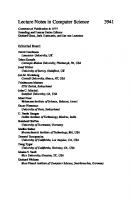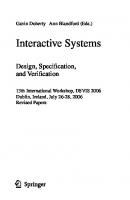Interactive Systems: Design, Specification, and Verification: 9th International Workshop, DSV-IS 2002, Rostock Germany, June 12-14, 2002 (Lecture Notes in Computer Science, 2545) 3540002669, 9783540002666
This book constitutes the thoroughly refereed post-proceedings of the 9th International Workshop on the Design, Specific
141 78 6MB
English Pages 279 [278] Year 2002
Table of contents :
Interactive Systems
Preface
Organization
Table of Contents
From a Formal User Model to Design Rules
Introduction
Formalising Cognitively Plausible Behaviour
The Erroneous Actions That Emerge
Design Rules
Conclusions and Further Work
A Coloured Petri Net Formalisation for a UML-Based Notation Applied to Cooperative System Modelling
Introduction
Related Work
UML Semantics versus CPN Semantics
Framework
Example of Cooperative Model
Organisation Group
Role Definition
Task Definition
Specification of Interactions between Actors
Semantics for the Cooperative Model
Translation Schemes from UML to CPN
Validation and Property Verification
Conclusions
Adaptive User Interface for Mobile Devices*
Introduction
State of the Art and Related Work
Adaptable XML-Defined Interfaces
Web Applications and Adaptable User Interfaces
Extensible User-Interface Language -- XUL
Mobile Agents and Agent Platforms
Using XUL with Mobile Agents in Multiple Platforms
A Motivating Example
XUL Implementation -- jXUL
Putting It All Together
A Sample Scenario: Mobile Calculator and Survey
Currency Converter Application
Survey Application
Conclusions and Future Work
Migratable User Interface Descriptions in Component-Based Development
Introduction
Describing User Interfaces for Embedded Systems
Abstracting the User Interface
An XML-Based User Interface Description
User Interface Descriptions and Components
The SEESCOA Component Framework
The Rendering Component
A Case Study: A Camera Surveillance System
Extending the Case Study: Decomposing Tasks
Flexible and Adaptable User Interfaces for Embedded Systems
Realising a Concrete UI
System Independent User Interfaces
Summary of Our Current Results
Conclusions and Future Work
Task Modelling in Multiple Contexts of Use
Introduction
The Development Process of Multi-context User Interfaces
Task Model
Introduction
Definition and Properties
Task Model for Multiple Contexts of Use
Introduction to the Context of Use
Context-Independent and Context-Partially-Independent Task Model
The Multi-context Task Model
A Case Study
Conclusion and Future Work
Notational Support for the Design of Augmented Reality Systems
Introduction
The City Project Scenario
ASUR Description of the Mackintosh Scenario
ASUR Concepts
Illustration of ASUR Using the Mackintosh Scenario
UMLi Description of the Mackintosh Scenario
ASUR and UMLi Comparison
Model-Based Design of AR Systems
Links between ASUR and UMLi
Conclusions and Perspectives
Tool-Supported Interpreter-Based User Interface Architecture for Ubiquitous Computing
Introduction
Survey Subsumption
Vesuf System
Vesuf Overview
Runtime Architecture
System Details
Domain-Adaptor Layer
Paths
Extended Constraint Semantics
Events and Dependencies
Presentation Metamodel Based on Functional Roles
Interoperation of the Concepts
Example
Conclusion and Outlook
Combining Compound Conceptual User Interface Components with Modelling Patterns – A Promising Direction for Model-Based Cross-Platform User Interface Development
Introduction
Problems with Model-Based User Interface Development Languages and Tools
Approaching a Possible Solution
The Proposed Modelling Approach
Discussion
Conclusions
Multiple User Interfaces: Towards a Task-Driven and Patterns-Oriented Design Model
Introduction
Multiple User Interface -- Definition and Characterization
Multiple User Interface Styles
Characteristics and Constraints
Relevant Background Works
Fertile Topics for Exploration
Vertical versus Horizontal Usability
Adaptation Strategies
Conclusion
Foundations of Cognitive Support: Toward Abstract Patterns of Usefulness
Introduction
Leveraging Mechanical Support Theory
The RODS Analogue to Mechanical Support
Core Theory of Cognitive Advantage
Small Vocabulary of Advantages
Compositional Language
Mnemonic, Evocative Names
Abstract, Generalizable Description Level
Analysis Framework
Toward Mining Patterns {em and} Theory
Related Work
Conclusions and Implications
User Interface Design Patterns for Interactive Modeling in Demography and Biostatistics
Introduction
Two Levels of Interaction
Data-Centric Modeling
UID Patterns for Analysis, Visualization, and Simulation
Two-Panel Selector
Objectives
Example
Solution
Discussion
Example of Usage
Interactive 2D User Input
Objectives
Examples
Solution
Discussion
Example of Usage
Multiple Observer with States
Objective
Example
Solution
Discussion
Example of Usage
Summary
User Interface Conceptual Patterns
Introduction
UI Conceptual Patterns
Examples of UI Conceptual Patterns
Using Patterns at the Analysis Phase
Refining the Specification
The $Delta $ (Delta) Effect
Design Approaches
Manual Design
Semiautomatic Design
Automatic Design
Deriving Implementations
Manual Programming
Code Reuse
Code Generation
Examples
Related Work
Conclusions
Monitoring Human Faces from Multi-view Image Sequences
Introduction
State of the Automatic Face Expression Recognition
Facial Action Coding System
Monitoring Approach Description
Facial Image Analysis
Image Frame Normalization
Face Feature Detection
Facial Action Units Classification
Face Mimic Graph
Monitoring of Facial Mimics
Conclusions
Improving Mouse Navigation – A Walk through the “Hilly Screen Landscape”
Introduction
Related Work
Description of the Hilly Screen Landscape
Concrete Usage Situations
Additional Functionality
Implementation Issues
Usability Evaluation Issues
Early Usability Tests
Later Usability Tests
Ongoing Work
Designing User Interaction for Face Tracking Applications
Introduction
Characteristics of Face Tracking Systems
Characteristics of a Minimal Face Tracking System
Characteristics of Facial Human-Computer Interaction (FHCI)
Characteristics of Human-Human Computer Mediated Facial Communication (CMFC)
Feedback in Face Tracking Applications
Reviewable (Non-real-Time Feedback)
Reflective (Real-Time Feedback)
Indirect
Face Tracking Applications
Mobile Videophone (CMFC)
Animation (CMFC)
Broadcast Television (CMFC)
Accessibility Aids (FHCI)
Affective Computing (FHCI)
Discussion
Manifested Interfaces
Interface Paradigms
Initialisation
Expression Representation
Trust in CMFC Systems
Conclusion
Performance Evaluation as a Tool for Quantitative Assessment of Complexity of Interactive Systems
Introduction
Interactive Cooperative Objects
Informal Description
Temporal Aspects
Currency Converters Case Study
Informal Presentation of Currency Converters
Tasks Models
System Model
Performance Evaluation
Performance Analysis Framework
Temporal Information Modelling
Exploiting Temporal Information
Conclusion
Blending Descriptive and Numeric Analysis in Human Reliability Design
Introduction
System Design and New Requirements
Human Reliability Analysis
THEA
The Domain and Scenario
Fragment of the THEA Analysis
Qualifying the Issues
Belief, Expert Judgement, and Structure
Design Issue Impact
Quantifying Issue Importance
HEART Overview
HEART Application to THEA
Numeric Impact
Discussion
Conclusions
Towards a Ubiquitous Semantics of Interaction: Phenomenology, Scenarios, and Traces
Introduction
Rationale
Bewildering Diversity
Common Semantics
Scenarios and Phenomena
Discrete Behaviour
Trace as Event Time Series
A Meta-model -- Instances and Happenings
Relating Behaviours
Turn-Taking and States
Interstitial Behaviour
Hierarchical and Layered Models
Temporal Granularity and Real Time
Continuous Behaviour
Summary
Architecture Considerations for Interoperable Multi-modal Assistant Systems
Overview: The {sc Embassi}{} Project
Middleware Challenges
The {sc Embassi}{} Architecture
The MMI Levels
The Assistance Levels
Additional Notes on the Generic Architecture
The Middleware Model
Component Types
Channels & Systems
Communication Patterns
Subscriptions
Message Handling
Related Work
Summary and Outlook
What Has Been Achieved So Far
Next Steps
Author Index
Interactive Systems
Preface
Organization
Table of Contents
From a Formal User Model to Design Rules
Introduction
Formalising Cognitively Plausible Behaviour
The Erroneous Actions That Emerge
Design Rules
Conclusions and Further Work
A Coloured Petri Net Formalisation for a UML-Based Notation Applied to Cooperative System Modelling
Introduction
Related Work
UML Semantics versus CPN Semantics
Framework
Example of Cooperative Model
Organisation Group
Role Definition
Task Definition
Specification of Interactions between Actors
Semantics for the Cooperative Model
Translation Schemes from UML to CPN
Validation and Property Verification
Conclusions
Adaptive User Interface for Mobile Devices*
Introduction
State of the Art and Related Work
Adaptable XML-Defined Interfaces
Web Applications and Adaptable User Interfaces
Extensible User-Interface Language -- XUL
Mobile Agents and Agent Platforms
Using XUL with Mobile Agents in Multiple Platforms
A Motivating Example
XUL Implementation -- jXUL
Putting It All Together
A Sample Scenario: Mobile Calculator and Survey
Currency Converter Application
Survey Application
Conclusions and Future Work
Migratable User Interface Descriptions in Component-Based Development
Introduction
Describing User Interfaces for Embedded Systems
Abstracting the User Interface
An XML-Based User Interface Description
User Interface Descriptions and Components
The SEESCOA Component Framework
The Rendering Component
A Case Study: A Camera Surveillance System
Extending the Case Study: Decomposing Tasks
Flexible and Adaptable User Interfaces for Embedded Systems
Realising a Concrete UI
System Independent User Interfaces
Summary of Our Current Results
Conclusions and Future Work
Task Modelling in Multiple Contexts of Use
Introduction
The Development Process of Multi-context User Interfaces
Task Model
Introduction
Definition and Properties
Task Model for Multiple Contexts of Use
Introduction to the Context of Use
Context-Independent and Context-Partially-Independent Task Model
The Multi-context Task Model
A Case Study
Conclusion and Future Work
Notational Support for the Design of Augmented Reality Systems
Introduction
The City Project Scenario
ASUR Description of the Mackintosh Scenario
ASUR Concepts
Illustration of ASUR Using the Mackintosh Scenario
UMLi Description of the Mackintosh Scenario
ASUR and UMLi Comparison
Model-Based Design of AR Systems
Links between ASUR and UMLi
Conclusions and Perspectives
Tool-Supported Interpreter-Based User Interface Architecture for Ubiquitous Computing
Introduction
Survey Subsumption
Vesuf System
Vesuf Overview
Runtime Architecture
System Details
Domain-Adaptor Layer
Paths
Extended Constraint Semantics
Events and Dependencies
Presentation Metamodel Based on Functional Roles
Interoperation of the Concepts
Example
Conclusion and Outlook
Combining Compound Conceptual User Interface Components with Modelling Patterns – A Promising Direction for Model-Based Cross-Platform User Interface Development
Introduction
Problems with Model-Based User Interface Development Languages and Tools
Approaching a Possible Solution
The Proposed Modelling Approach
Discussion
Conclusions
Multiple User Interfaces: Towards a Task-Driven and Patterns-Oriented Design Model
Introduction
Multiple User Interface -- Definition and Characterization
Multiple User Interface Styles
Characteristics and Constraints
Relevant Background Works
Fertile Topics for Exploration
Vertical versus Horizontal Usability
Adaptation Strategies
Conclusion
Foundations of Cognitive Support: Toward Abstract Patterns of Usefulness
Introduction
Leveraging Mechanical Support Theory
The RODS Analogue to Mechanical Support
Core Theory of Cognitive Advantage
Small Vocabulary of Advantages
Compositional Language
Mnemonic, Evocative Names
Abstract, Generalizable Description Level
Analysis Framework
Toward Mining Patterns {em and} Theory
Related Work
Conclusions and Implications
User Interface Design Patterns for Interactive Modeling in Demography and Biostatistics
Introduction
Two Levels of Interaction
Data-Centric Modeling
UID Patterns for Analysis, Visualization, and Simulation
Two-Panel Selector
Objectives
Example
Solution
Discussion
Example of Usage
Interactive 2D User Input
Objectives
Examples
Solution
Discussion
Example of Usage
Multiple Observer with States
Objective
Example
Solution
Discussion
Example of Usage
Summary
User Interface Conceptual Patterns
Introduction
UI Conceptual Patterns
Examples of UI Conceptual Patterns
Using Patterns at the Analysis Phase
Refining the Specification
The $Delta $ (Delta) Effect
Design Approaches
Manual Design
Semiautomatic Design
Automatic Design
Deriving Implementations
Manual Programming
Code Reuse
Code Generation
Examples
Related Work
Conclusions
Monitoring Human Faces from Multi-view Image Sequences
Introduction
State of the Automatic Face Expression Recognition
Facial Action Coding System
Monitoring Approach Description
Facial Image Analysis
Image Frame Normalization
Face Feature Detection
Facial Action Units Classification
Face Mimic Graph
Monitoring of Facial Mimics
Conclusions
Improving Mouse Navigation – A Walk through the “Hilly Screen Landscape”
Introduction
Related Work
Description of the Hilly Screen Landscape
Concrete Usage Situations
Additional Functionality
Implementation Issues
Usability Evaluation Issues
Early Usability Tests
Later Usability Tests
Ongoing Work
Designing User Interaction for Face Tracking Applications
Introduction
Characteristics of Face Tracking Systems
Characteristics of a Minimal Face Tracking System
Characteristics of Facial Human-Computer Interaction (FHCI)
Characteristics of Human-Human Computer Mediated Facial Communication (CMFC)
Feedback in Face Tracking Applications
Reviewable (Non-real-Time Feedback)
Reflective (Real-Time Feedback)
Indirect
Face Tracking Applications
Mobile Videophone (CMFC)
Animation (CMFC)
Broadcast Television (CMFC)
Accessibility Aids (FHCI)
Affective Computing (FHCI)
Discussion
Manifested Interfaces
Interface Paradigms
Initialisation
Expression Representation
Trust in CMFC Systems
Conclusion
Performance Evaluation as a Tool for Quantitative Assessment of Complexity of Interactive Systems
Introduction
Interactive Cooperative Objects
Informal Description
Temporal Aspects
Currency Converters Case Study
Informal Presentation of Currency Converters
Tasks Models
System Model
Performance Evaluation
Performance Analysis Framework
Temporal Information Modelling
Exploiting Temporal Information
Conclusion
Blending Descriptive and Numeric Analysis in Human Reliability Design
Introduction
System Design and New Requirements
Human Reliability Analysis
THEA
The Domain and Scenario
Fragment of the THEA Analysis
Qualifying the Issues
Belief, Expert Judgement, and Structure
Design Issue Impact
Quantifying Issue Importance
HEART Overview
HEART Application to THEA
Numeric Impact
Discussion
Conclusions
Towards a Ubiquitous Semantics of Interaction: Phenomenology, Scenarios, and Traces
Introduction
Rationale
Bewildering Diversity
Common Semantics
Scenarios and Phenomena
Discrete Behaviour
Trace as Event Time Series
A Meta-model -- Instances and Happenings
Relating Behaviours
Turn-Taking and States
Interstitial Behaviour
Hierarchical and Layered Models
Temporal Granularity and Real Time
Continuous Behaviour
Summary
Architecture Considerations for Interoperable Multi-modal Assistant Systems
Overview: The {sc Embassi}{} Project
Middleware Challenges
The {sc Embassi}{} Architecture
The MMI Levels
The Assistance Levels
Additional Notes on the Generic Architecture
The Middleware Model
Component Types
Channels & Systems
Communication Patterns
Subscriptions
Message Handling
Related Work
Summary and Outlook
What Has Been Achieved So Far
Next Steps
Author Index

- Author / Uploaded
- Bodo Urban (editor)
- Jean Vanderdonckt (editor)
- Quentin Limbourg (editor)









